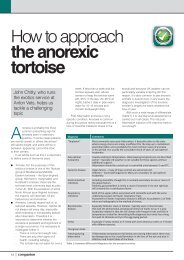Companion May 2012 - BSAVA
Companion May 2012 - BSAVA
Companion May 2012 - BSAVA
You also want an ePaper? Increase the reach of your titles
YUMPU automatically turns print PDFs into web optimized ePapers that Google loves.
Chronic kidney<br />
disease in dogs<br />
26 | companion<br />
Dr Joy Archer of the University of<br />
Cambridge describes how<br />
PetSavers funding has helped<br />
carry out research into chronic<br />
kidney disease in dogs<br />
Research into chronic kidney disease in<br />
dogs was motivated by awareness from our<br />
routine diagnostic work that increasing<br />
numbers of older dogs and cats were being<br />
referred for CKD.<br />
With current laboratory tests CKD is not always<br />
diagnosed at the early stages where intervention and<br />
treatment would be most effective. This is partly due to<br />
the problems of not having widely available sensitive<br />
tests and not knowing which animals with changed<br />
tests values will progress to chronic disease. Before<br />
there are increases in the blood levels of urea,<br />
creatinine and phosphorus there is usually a marked<br />
loss of kidney function.<br />
Testing and monitoring<br />
Urine tests are more sensitive but many are affected<br />
by conditions other than CKD and also by sample<br />
handling. Urine specific gravity is a sensitive test of<br />
loss of urine concentrating ability but is dependent on<br />
many variables, including the hydration status of the<br />
patient and other constituents in the urine (e.g. blood).<br />
A more widely used moderately sensitive urine test is<br />
the measurement of the urine protein:creatinine ratio. If<br />
this is > 0.4 in dogs and > 0.2 in cats there is a strong<br />
suggestion that the animal may be developing CKD.<br />
Likewise animals with persistent albuminuria<br />
should also be monitored for progression to CKD.<br />
There is an automated method for measuring albumin<br />
in urine but it is not widely used and the available<br />
dipsticks for canine and feline microalbumin are<br />
expensive and no longer widely used in practice. The<br />
most sensitive and specific method available is the<br />
measurement of changes in GFR (glomerular filtration<br />
rate) by clearance of endogenous or exogenous<br />
creatinine or iohexol.<br />
However, these are expensive, time-consuming<br />
methods which involve numerous timed blood and<br />
urine sample collections. In human medicine,<br />
measurement of endogenous cystatin C in plasma<br />
(Left) Cambridge Resident Paola Monti who worked on the PetSavers and RCVS Trust funded project and (right) Dr Joy Arthur



